Loading component...
At a glance
Every day, we act as negotiators.
However, we seldom think about the skills required or the processes we must follow to negotiate successfully, according to Chas Savage, CEO of Ethos CRS, a company that specialises in customised capability training in communications, regulation, policy and leadership.
In his CPA Congress address, “Mastering your negotiation skills”, he examines the requirements of successful negotiations, especially in business.
“The negotiating process is about how you can create and increase value,” Savage told CPA Congress delegates.
“Ideally, it involves a conclusion that involves everyone walking away satisfied.”
Types of negotiations
There are two types of negotiations. The first is transactional. One side gains while the other side loses, at least in the short term.
The zero-sum nature involved means that this type of negotiation is not suitable if there has to be a long-term relationship between the parties.

The other type, collaborative negotiations, is one in which both sides maximise their gains and minimise their losses because they work to realise common objectives.
“It is important that you don’t mistake one for the other,” says Savage.
“Any negotiations require clarity of mind – and a lot of homework. You must understand what the other side wants, both the practical elements and the psychological needs. Yes, negotiation is a form of manipulation, but that does not mean that it cannot work out to the benefit of both parties.”
As an exercise, Savage asked the audience to put themselves in the position of the North Korean negotiators dealing with the US team and President Donald Trump, trying to reach an agreement over nuclear weapons. This helped to understand how to assess the needs of those on the other side of the table.
Planning needed for effective negotiating
Much of the hard thinking has to be done even before negotiations begin. What is your real objective? What are you willing to do to achieve it? What do you think the other side is trying to achieve, and what will they give up? What is the anticipated outcome, your minimum acceptable outcome, and your ideal outcome? Is no deal better than a bad deal?

A critical part of this is knowing what you will do if negotiations fail. This is called the best alternative to a negotiated agreement, or BATNA.
The key is to establish and expand the areas of agreement. This is the zone of possible agreement, or ZOPA. The larger the ZOPA, the more the two sides will seek to collaborate.
“Business negotiations are generally done by teams,” Savage notes. “Everyone in the team must know what their role is and who is leading the team. The last thing you want is your own people contradicting each other or not having required information to hand.
“The good cop/bad cop tactic, where one member of the team makes extreme demands and another one offers a more moderate position, can be useful, but everyone has to know exactly what they are doing.”
Depending on the nature of the negotiations, it can be very useful to conduct a test run with an opposing team. Gaming can reveal potential problems and weaknesses, which can be addressed before the real thing starts.
Negotiating tactics and trust
Good preparation makes for good negotiations, but across-the-table tactics are also crucial. A solid start is to cite standards, precedents and the benefits of an agreement. This will provide a framework for discussion.
From here, it should be possible to divide the negotiations into small steps to minimise risks and misunderstandings. However, there has to be a clear focus on the overall objective, and disputes on unrelated issues should be closed down immediately.
“There needs to be an element of trust,” says Savage. “That doesn’t mean you have to like each other. It just means that you have to know the other side can and will deliver on their commitments, and they know that you can and will deliver on yours.”
A useful idea is to draft an agreement document as soon as possible in the process, to give discussions a focal point. However, ensure that there is only one copy in circulation at a time. The two sides having different documents is a recipe for conflict, and an undermining of trust. Do not, Savage emphasises, allow the other side to draft the document.
Closing a negotiation
“In the closing stage, look for things like fading counter-arguments, body language suggesting fatigue, and converging positions,” he says.
“The end is then in sight. Once there is an agreement, follow up promptly on the commitments you have made.”
Savage makes the point that the negotiation process can be intellectually and physically demanding. Complex negotiations require a high level of concentration over an extended period.
“Make sure you are healthy and relaxed,” Savage suggests. “There should be planned time and resources for rest and recovery. It’s hard work, after all.”

